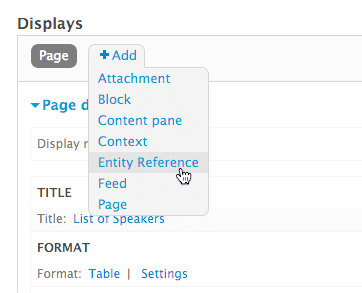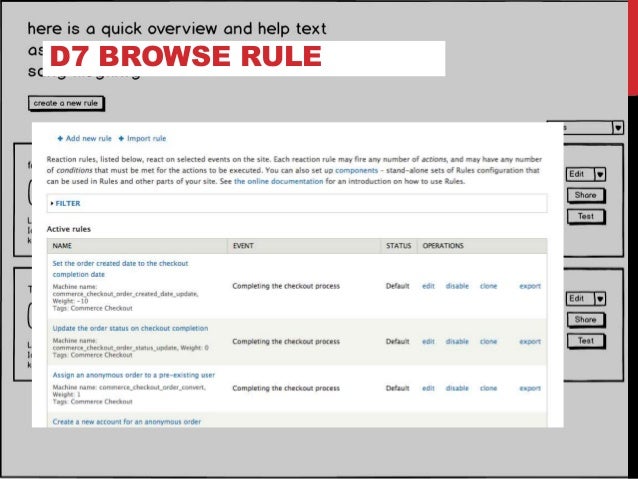


- Drupal rules add field to entity install#
- Drupal rules add field to entity code#
- Drupal rules add field to entity download#
To keep the added functionality of the numeric field handler, we'll copy the super class's code into our module and then change it as necessary. We are getting 0 for everything.Īnother over-ridden function is needed. Now, with the module enabled and the field added we get can see the view.Īll is going well except the output is correct. To fix this, we'll over-ride the query function in our handler and stop the addition of the field to the SQL query. SQLSTATE: Column not found: 1054 Unknown column 'node.total' in 'field list' Now when the module is enabled and the field is added, a lot of extra functionality is added from the parent class. Now, in views/mymodule_sum_fields.inc, we'll sub-class one of the standard handlers, views_handler_field_numeric, and start to implement the handler. There are a few different handlers for views ( ) but, for the moment, we are only interested in field handlers.Īnd tell Drupal about it in. Creating a HandlerĪ handler contains the code which needs to be run. Now when the module is enabled, we can find the new field in the list.Īs suggested, a “handler” needs to be created. When a user submits and entityform I would like to send an. If the user selects an entity form then when the contact page is rendered so is the referenced entityform. 'help' => t('Sums the numeric fields in a node'), The content type contact page has two fields on it one entityreference field that is used to reference an entityform and the other a text field used to store an e-mail address. When try to add a 'Change Entity Form Field' action for the first time, after click on save button, show this error: Warning: count(): Parameter must be an array or an object that implements Countable in DrupalbusinessrulesPluginBusinessRulesActionChangeFieldInfo->getRows(). With this, Views will try to load views/, so we should now create this. 'path' => drupal_get_path('module', 'mymodule'). And in there, create two files called and mymodule.module. So in our sites/all/modules directory we create a new folder called mymodule. To start, we go through the standard way to create a new module ( ). On this View, we want to display the the total of the numeric fields on all the nodes, so we'll get to work developing our module. Adapting for multiple value fields is left as an exercise for the reader.Īdd some dummy content using drush and devel. NOTE: this module will only expect single value fields. The fields use the default settings, but can be changed if required. Then create some node types – type 1 and type 2 – each one with some integer fields. You will next need to enable the following modules:
Drupal rules add field to entity download#
Or use Drush with the make file which you can download using this link or from the files link at the bottom of this article. Field definitions Entity types define their base fields in a static method on the entity class. The field definitions are based on the Typed data API (see how entities implement it ).
Drupal rules add field to entity install#
To develop this module we first install Drupal and a few modules. Content entities have to define all their fields explicitly by providing definitions for the entity class. Hope that helps someone else along the way in the Drupal Journey.To start, we'll create a new composite field (or pseudo-field) for Views.
(Profile 2 can also have multiple profiles associated with a user, for example, a professor and an employee profile)… it seems that both of these approaches use the Drupal 7 entity api… which opens it up for use with tokens (if you install/enable the Entity Tokens module which is part of the Entity API extension module), Rules and Features. D8/D9 Field Hidden defines hidden field widgets element widgets for these core field types: decimal, float, integer (plain)text, (plain)long text Hidden in forms.This is the primary difference between the two methods of adding fields to a user profile. Instead of adding entity related events to Reaction Rules you are able to select which Rules will fire from the bundle management page. This provides an alternative method of triggering Rules. If you have the need to add fields that are “private” and can only be seen by the user and the admin, you may want to consider using the Profile 2 module. Entity Rules provides a page for selecting and creating Rules components that will be executed when different operations happen to an Entity of a particular bundle. You may find the same information here, but I wanted to share here to help provide the information locally and provide a snapshot in time difference between using just the Fields API and using the Profile 2 module. Enable it and you’ll be able to see the tab and add fields to your user profiles to your heart’s content.

If you don’t see it… that means you don’t have the “Field UI” module enabled. If you’re looking to add a field to a User Profile in Drupal 7… you’ll be able to do it on the Configuration > People > Account Settings page… there, you should find a “Manage Fields” tab at the top of the overlay (just beside the close button for the overlay).


 0 kommentar(er)
0 kommentar(er)
